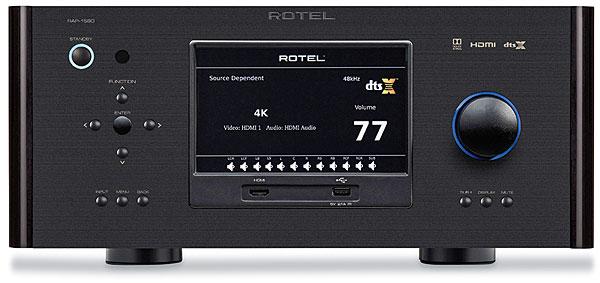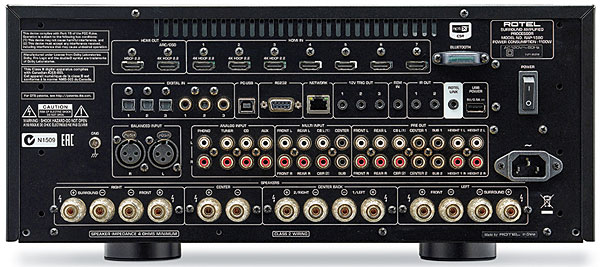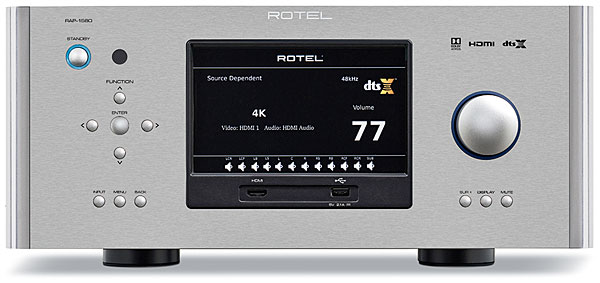Clean power with no hesitation of clipping or overheating.
I have a ten inch diamater fan over my Yamaha Receiver and ten inches of clearance, and still I tread lightly when pushing my receiver.
Granted I love to crank it up on Dynamic passages of both music and movies.
Rotel's 1580 seems to be a great alternative for folks like me.
However with HDMI 2.1 just months away, I will wait and see what the market bears this time next year.
By the way, I love the old school aluminum silver model of the 1580.
Rotel RAP-1580 Surround Amplified Processor Review

AT A GLANCE
Plus
Muscular Class A/B amp
PC-USB and phono inputs
Dolby Atmos and DTS:X 7.1.4 decoding
Minus
No auto setup
Limited access to seven-channel amp for Atmos/DTS:X
THE VERDICT
Rotel returns to analog amplification for their latest top-of-the-line home theater machine—and the results are golden.
Is the Rotel RAP-1580 the surround receiver that dares not speak its name? In keeping with the two-channel distinction between stereo receivers and integrated amplifiers, Rotel calls it a surround amplified processor because it doesn’t include an AM/FM tuner. But to my mind, the defining trait of a surround receiver is that it combines a surround preamp/processor and a multichannel amp in one box. So I prefer to call this an audiophile receiver. You say tomato... [Editor’s Note: I’d call it a surround amplifier, and I don’t think it’s the last of this type we’ll be seeing...but, whatever.—RS]
Life isn’t easy for audiophile surround products, whatever you call them. They are reviled from one side for not having enough features— and reviled from the other side for being, well, an oxymoron, as if surround sound shouldn’t even aspire to audiophilia. But there’s a determined cadre of home theater buffs who are thrilled by the dynamics and subtleties of a great movie soundtrack. Some of them even collect music in high-resolution surround and stereo formats. I count myself among them.
And I love audiophile receivers. I gave up on surround separates years ago, as soon as the first true audiophile receivers became available. Some of the most convincing ones came from Rotel, one of the pioneers of relatively affordable audiophilia. Rotel poured so much love, know-how, and aspiration into the RSX-1065 and -1067 receivers—with their distinctive front-panel heat fins and golden, dynamic sound—that the existence of audiophile receivers could no longer be disputed. Such receivers were like quarks, antibiotics, and Post-it notes: Once discovered, they couldn’t be undiscovered.
Back to Analog
Rotel’s only other current surround receiver, one that proudly wears the name, is the RSX-1562. That fiveyear-old model uses ICEpower Class D amplification. However, it predates Dolby Atmos and DTS:X and can’t be upgraded to add them. The company also offers surround pre/pros and multichannel amps.
Available in silver or black, the RAP-1580 returns to Class A/B amplification, scene of earlier Rotel triumphs. The brawny 50-pounder is rated at 100 watts per channel into 8 ohms with all seven channels driven, a spec that most manufacturers prefer to dodge, rating into only stereo loads instead. See our Test Bench measurements for an independent look. I’m guessing it will be close to the rating. Demanding 4-ohm speakers are gleefully challenged to an arm-wrestling contest.

The RAP-1580 owes much of its weight to the massive Rotel-made toroidal power transformer, a key ingredient in the secret sauce. My lights flickered when I turned it on. I worried that the 1.4-inch window of daylight allowed by my rack’s guest-receiver berth wasn’t enough for its ventilation needs and therefore added a small fan to blow air through the gap. Putting the product in an unventilated gear closet or stacking other components on it would be inadvisable.
Memo to Dolby Atmos and DTS:X enthusiasts: In what amounts to an oddity, if not an outright design flaw, the seven available onboard amp channels are limited in their ability to be configured for Atmos. Although the surround processor section supports up to 7.1.4 channels, without adding external amplification you can only assign the onboard amps for a 5.1.2-channel setup, with a single pair of Atmos/DTS:X height channels, or a traditional 7.1-channel system with a pair of back surrounds. Given the onboard processing, logic would suggest that stepping up to 5.1.4, with four height channels, should then require only the addition of a single stereo amplifier, but you’ll actually need four external amp channels with this setup— the sixth and seventh internal channels simply go unused in a 5.1.4 configuration. Stepping up to a 7.1.4 system allows you to call those internal amps back into play for the back surround channels, but you’ll still require four outboard amp channels to drive the height speakers. Rotel says this problem will be addressed in a future software update, though the company cited no immediate time frame.
(Another odd quirk was that the master volume control on the remote did not affect test-tone levels, which would have required me to balance channels well below reference level. However, the volume knob on the front panel did affect the test tones, so I just ran to and fro between front panel and sweet spot, making hairline adjustments with the knob and checking the meter. Fortunately, this problem was subsequently addressed in software update V1.71, so you shouldn't suffer that inconvenience.)

Dominating the front panel is an unusually large display, 6 inches wide by 3.5 tall. It is mostly monochrome, aside from a touch of yellow for the X of the DTS:X logo. Seeing so much information at a glance is helpful (if a little geeky). The two numerals representing master volume get the biggest play. The TV-screen interface is also monochrome. At left are menu navigation buttons and a blue-ringed power button, whose intensity can be reduced with included stick-on ring covers. At right, below the volume knob, are minimal controls for surround mode, mute, and display (front panel and TV displays on, one off, or both off). The remote control is plain but decently organized. It reserves its top row of buttons for on-the-fly adjustments of subwoofer, center, and surround levels. An app for mobile devices is in development; Rotel's existing app for other products didn’t apply at press time.
Eight HDMI inputs include seven in back and one in front. There are two HDMI outputs. Three inputs and one output are Ultra HD capable, but none support scaling, only passthrough. There are no component or composite video jacks. However, multichannel analog connections are supported, 7.1-channel in and 11.1-channel out, with connections for an extra center and subwoofer or biamp applications. Coaxial digital, optical digital, and stereo analog inputs are present in triplicate. Also provided are moving-magnet phono, stereo XLR line, and iOS-friendly front-panel USB inputs. Rotel can’t be praised highly enough for providing a second, PC-friendly USB input supporting 192/24 hi-res audio—something that remains a rarity in any receiver, but shouldn’t be. Note, however, that the network connection for the unit is wired Ethernet only (no Wi-Fi option). As mentioned, AM and FM reception is not supported, but neither are music streaming services, and there’s no headphone jack. The only wireless option is an aptX capable Bluetooth connection to send signal from a smartphone/tablet or laptop.
- Log in or register to post comments


Dennis Burger over at HomeTheaterReview.com (former S&V Contributor/Editor Adrienne Maxwell's site) reviewed this unit. Below are my comments. Ok....save on the tuner = more robust power supply and amplification. That does not justify the absence wifi, ehernet (for streaming internet music) and room correction. Room correction is a critical feature that is needed with the complex surround processing capabilities this unit and Rotel does it buyers a shameful disservice by not licensing Audyssey or Dirac. There is not an argument leadership at Rotel could make to excuse the above exclusions. I refuse to believe Rotel's customers wouldn't appreciate or fork over the extra coin for these features which nowadays are not 'bells and whistles'. Unacceptable for the price, performance notwithstanding.


That can be handled by HDMI as well. I currently use my PC that way. I also have a DIY 4495SEQ DAC connected to my PC (Windows 10 now recognizes USB Audio 2.0 with the addition of the Creators update).
Room correction can also be handled via a PC through a number of ways Dirac...but costly, Audiolense -costly as well, REW -Free, and MathAudio Room EQ (inexpensive) just to name a few....there's even a Windows apo based solution called APO Equalizer, totally free.

There is merit to the argument that some audiophiles do not favor room correction, but is this product solely built for audiophiles. I would think that Rotel's management would desire to 'cast a wide net' and design a product that would appeal to many potential buyers not just we 'philes'. After all, it is a for profit company. It does not excuse the lack of room correction at this price point. If a 'phile' does not like it, a simple button press or swipe of a finger on the downloaded control app can turn it off. Oh wait, what use would a control app be without WiFi. It is just shameful that Rotel charges this price. No one's room has perfect acoustics and when using Atmos or DTS-X, room correction is needed for the vast majority of users. Period. Prospective buyers would be better off buying separates or cheaper A/V receiver with multi channel pre-outs to connect a standalone multichannel amplifier such as one from say.....Emotiva or Outlaw or Wyred 4 Sound.
Side note: Hope you and Robin Sabin do a Pixel and Bits episode on satellite/sub versus full range speaker use in home theater applications.

I feel like in the current environment it's getting very hard to choose a receiver. I'm looking to upgrade soon (more HDMI inputs, atmos/DTS:X, better tech and sound) from a 10 year old receiver that's still crushing 7.1 sound like it's nobody's business! But with such quality products from Yamaha, Pioneer, Denon, and Marantz, it's tough to choose. I like reading these reviews, but it's hard to tell at which price points which receivers are actually providing any better value or better sound for the buck. Also, in this day and age, are separates even worth considering over a receiver? Are there true audio gains in the mid-range tier? For example, one could save $1,000 getting a Marantz 7703 over the new 7704 and use the savings on external amps. Would this deliver better sound then a Marantz 7012 (or even last year's 7011)? With savings on the receiver or last year's model and then purchase a 2-channel amp to provide the full 11 channels needed for Atmos, is there any benefit to spending more on Separates? For this Rotel, how much better is this than a Marantz 7704 + amps bringing it to the same price point?
I'm upgrading from an old Denon 4308. Are receivers 10 years later that much better that i wouldn't be missing much by not going separates? Where's the point of diminishing returns right now?

At $3800, certain features must be present to be competitive. Some fool will buy it.

I cannot remember the last time I listened to FM at home...and I'm old. Yeah, this receiver is a bit quirky for me. No Atmos on one channel except for every third Wednesday..thats a bit much to take.....however I would give their 1582 processor a chance with separate amps maybe Bryston or some of the new ATI gear

Mark, what about those that have two subwoofers? Is there a way to have stereo subs, or do they need to be daisy changed and configured as a mono channel? This looks very enticing, but not having two sub inputs is a problem.

I took the plunge with the Rotel RAP 1580. Upgrading from an Arcam FMJ AVR400. Absence of auto calibration is not a factor, I'm old school when it comes to setup. Audio performance is excellent, using the RAP1580 in a combined Audio and HT setup where the Left/Right main speakers are driven by Pass Labs X250.8 2-channel amp. Pros: High performance audio with excellent sound quality (B&W 803D3s, HTM2D3 center, 2 pairs B&W SCSM as surrounds and rear speakers in 7.1 setup). Dual subwoofer outputs (hooray, although they are in parallel) coupled with twin REL G-1 subs. Cons: So far, only one. There is an apparent bug in the firmware that results in the OSD image flipping upside down (the onscreen setup menus thankfully do not invert). Only cure so far (and this recommendation came from a very responsive Rotel rep; this is apparently a known issue) is to do a cold reboot (corrects the issue sometimes) or do a System Reset and return the unit back to its default specs (which requires one to reenter all of your setup info). Thankfully the setup menus are easy to navigate...just make sure you have recorded your settings before doing the reset. It takes me about 5 minutes to reenter all my settings. Verdict: "The jury is out." Outstanding audio performance with no frills, but early bugs with the OSD have me pondering whether to return the unit and look elsewhere. I very must want a unit with a silver faceplate since this piece of kit rests on a rack along side all silver gear (Pass Labs XP-20 and X250.8), Modwright Oppo 105D and power supply (both in silver), and Shunyata Hydra Triton and DPC-6 A/C conditioners. For what I suspect is purely cost vs. expected sales reasons, very few high quality AV receivers or separates remain available in silver finish. The plague of ubiquitous black boxes is run amok. Some of us actually like to display the gear we collect.































































